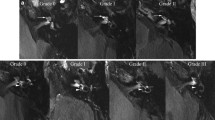Abstract
Our objective is to determine whether the degree of endolymphatic hydrops as it is detected in vivo in patients with definite Meniere’s disease correlates with audiovestibular function. In this prospective study, 37 patients with definite Meniere’s disease according to AAO-HNS criteria were included. Intratympanic contrast enhanced temporal bone MRI was performed using a 3D FLAIR protocol. The degree of endolymphatic hydrops in the cochlea and the vestibulum was graded on a Likert scale (0–3). The degree of hydrops was then analyzed with respect to its correlation with audiometric hearing levels, electrocochleographic SP/AP ratios, interaural amplitude ratios of vestibular evoked myogenic potentials and degree of horizontal semicircular canal paresis on caloric irrigation. There was a significant correlation between the degree of hydrops on the one hand and the averaged hearing level at 0.25–1 and 0.5–3 kHz and the vestibular evoked myogenic potential interaural amplitude ratio on the other hand. A trend toward a correlation was noticed between the hydrops and the caloric response, no correlation was noticed between the hydrops and the SP/AP ratio. The degree of endolymphatic hydrops correlates with a progressive loss of auditory and sacculus function in patients with Meniere`s disease.










Similar content being viewed by others
References
Hallpike CS, Cairns H (1938) Observations on the pathology of Meniere’s syndrome. J Laryngol Otol 53:625–655
Yamakawa K (1992) Histopathology of Meniere’s patient reported in 1938. Arch Otolaryngol Head Neck Surg 118:660–662
Xianxi Ge, Shea John J Jr (2002) Transtympanic electrocochleography: a 10-year experience. Otol Neurotol 23:799–805
Nakashima T, Naganawa S, Sugiura M, Teranishi M, Sone M, Hayashi H, Nakata S, Katayama N, Ishida IM (2007) Visualization of endolymphatic hydrops in patients with Meniere’s disease. Laryngoscope 117:415–420
Pyykko IJ, Zou J, Poe D, Nakashima T, Naganawa S (2010) Magnetic resonance imaging of the inner ear in Meniere’s disease. Otolaryngol Clin North Am 43(5):1059–1080
Committee on Hearing and Equilibrium guidelines for the diagnosis and evaluation of therapy in Meniere’s disease (1995) American Academy of Otolaryngology-Head and Neck Foundation, Inc. Otolaryngol Head Neck Surg 113(3):181–185
Basta D, Todt I, Ernst A (2005) Normative data N1/P1-latencies of vestibular evoked myogenic potenzials induced by air- or bone-conducted bursts. Clin Neurophysiol 116(9):2216–2219
Hallpike CS (1956) The caloric tests. J Laryngol Otol 70(1):15–28
Jongkees LB, Maas JP, Philipszoon AJ (1962) Clinical nystagmography. A detailed study of electro-nystagmography in 341 patients with vertigo. Pract Otorhinolaryngol 24:65–93
Nakashima T, Naganawa S, Pyykko I, Gibson WP, Sone M, Nakata S, Teranishi M (2009) Grading of endolymphatic hydrops using magnetic resonance imaging. Acta Otolaryngol 129:5–8
Zou J, Poe D, Bjelke B, Pyykko I (2009) Visualization of inner ear disorders with MRI in vivo: from animal models to human application. Acta Otolaryngol 129:22–31
Acknowledgments
This project was supported by funds from the German Federal Ministry of Education and Research under the Grant code 01 EO 0901. The authors bear full responsibility for the content of this publication.
Conflict of interest
None.
Author information
Authors and Affiliations
Corresponding author
Rights and permissions
About this article
Cite this article
Gürkov, R., Flatz, W., Louza, J. et al. In vivo visualization of endolyphatic hydrops in patients with Meniere’s disease: correlation with audiovestibular function. Eur Arch Otorhinolaryngol 268, 1743–1748 (2011). https://doi.org/10.1007/s00405-011-1573-3
Received:
Accepted:
Published:
Issue Date:
DOI: https://doi.org/10.1007/s00405-011-1573-3




